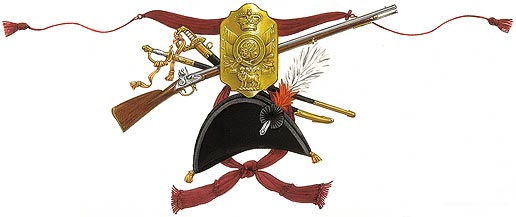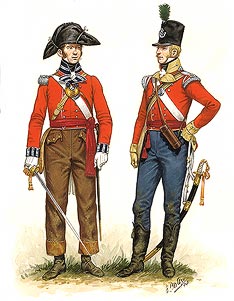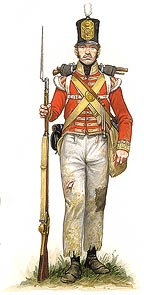Vittoria 1813

 |
| Battalion Company Officer of the 2nd Foot and a Light Infantry Company Officer of the 31st Foot." |
The 2/31st continued to see action in the Peninsula and was to join the Queen’s (Second) Royal Regiment of Foot at the Battle of Vittoria, 21st June 1813. This has been described as Wellington’s greatest victory of the War, as his allied Army marched from Spain, over the Pyrenees and into France.
 |
| Grenadier of the Grenadier Company |
The French armies were commanded by King Joseph, Napoleon’s brother, and Marshal Jourdan. Wellington had advanced rapidly in 1813, outflanking the French defence line and causing the French abandonment of Madrid. On 17th June, the French had been outflanked by the main allied army, which had turned north to Medina de Pomar, just fifty miles west of Vittoria, whilst they continued to be harassed by irregular Spanish cavalry. They halted in the valley of Vittoria.
Wellington divided his army into four parts. Lord Hill led the British 2nd Division, one Portugese (Silveira’s) Division and one Spanish division to the west and Picton’s and Dalhousie’s division were to move from the north. Wellington was to lead a frontal assault with the Light and 4th Division, while the British 1st and 5th Divisions with two Portugese brigades and the Spanish were to swing further to the north to cut the escape road to Bayonne.
The Queen’s formed part of Silveira’s Portugese Division and the 2/31st were part of General Stewart’s 2nd Division. Both battalions were part of the right column.
French collapse was absolute and this action practically ended the Peninsula War. The French lost virtually all of their artillery, ammunition, provisions, money and baggage, including King Joseph’s personal belongings. Wellington was given a field marshal’s baton.
Many styles of uniform were worn in the Peninsula and many of them were not smart! Wellington was more concerned about the supply of arms and equipment, than the Army’s appearance; the plates are, therefore, a representative view of the uniforms worn in the Peninsula.
Related
